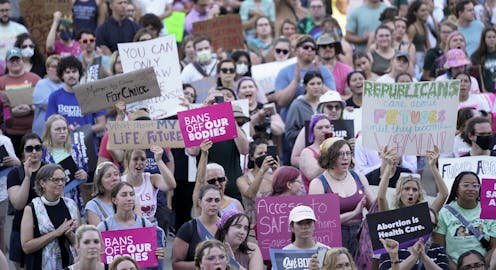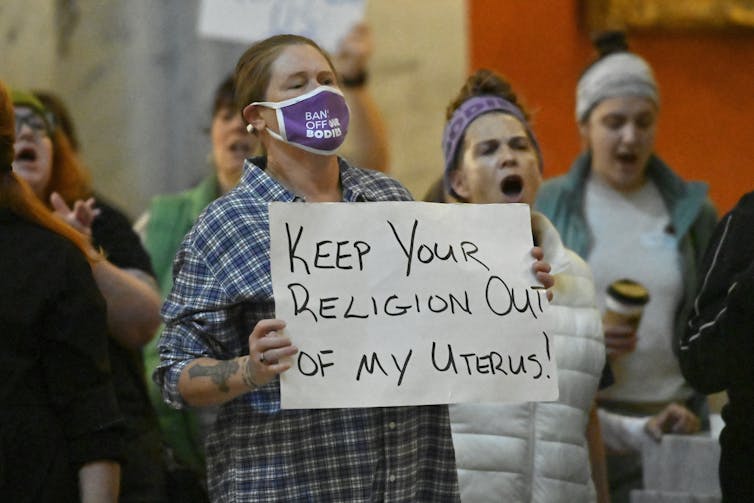
The Dobbs v. Jackson Women’s Health Organization decision by the United States Supreme Court earlier this year overturned constitutional protections of reproductive choice for Americans.
The ruling sparked protests, political action and outreach to women affected by the decision, including a flood of financial contributions to pro-choice organizations and causes.
Crowdfunding campaigns have been part of the story of financial support for reproductive justice in the aftermath of the Supreme Court decision. But while these campaigns have been massively successful by the standards of crowdfunding, they also raise significant concerns.
Repercussions
Financial needs arising from the Dobbs decision are acute. In addition to money for political and legal activism at the federal and state levels, women in states with newly restrictive abortion laws have been forced to cross state lines to access reproductive services.
These needs require support that may not be available from employers and insurance companies, particularly against a backdrop of policy change and legal uncertainty.
Women travelling to seek reproductive care as a result of Dobbs have reported being forced to take out loans or dip into their savings, and are struggling to pay rent and other bills.
In the two months after the Dobbs decision, approximately 10,000 fewer legal abortions took place in the U.S. By the end of October 2022, at least 66 U.S. abortion providers had closed.
Clinics in states with newly restrictive laws must now seek legal advice about whether they can remain open while also exploring relocating to more permissive states.
Given these new realities, many people have been moved to donate to women in need of abortions, funds and organizations that provide access to abortion, and political and legal advocacy groups that work to protect reproductive choice.
Influx of funds
The National Network of Abortion Funds, for example, says it received US$1.5 million the week the Dobbs decision was leaked in May 2022, and more than US$3 million from 33,000 donors on June 24, 2022, the day of the Supreme Court ruling.
Social media has been key to organizing online giving as well — activist Olivia Julianna helped raise more than $2.3 million for the Gen-Z for Choice Abortion Fund after being body-shamed by Republican representative Matt Gaetz.
While the majority of this fundraising activity has taken the form of direct donations to individuals and organizations, others have used crowdfunding to facilitate giving.
A surge in donations
My preliminary research has found that between May 2, 2022 — when the Dobbs decision was first leaked — and the Nov. 8, 2022 midterm elections in the U.S., 308 American crowdfunding campaigns on the GoFundMe platform raised almost US$3.2 million from more than 41,000 donations.
This included money for campaigns for abortion access funds like the National Network of Abortion Funds, organizations and protest movements seeking to protect and expand reproductive rights and women seeking abortion access.
Recent giving through crowdfunding is markedly different than abortion-related crowdfunding prior to Dobbs. When a colleague and I looked at these fundraisers in 2018, we only identified five campaigns for abortion funds compared to 226 following the Dobbs ruling. The 2018 fundraisers were also much more focused on individuals.
In addition to being more focused on pro-choice organizations, the recent abortion rights fundraisers are also much more successful than earlier abortion access campaigns. In 2018, campaigns seeking to provide abortion access averaged four donors with US$138.82 pledged per campaign, whereas the post-Dobbs campaigns attracted an average of 135 donors with US$10,300 pledged per campaign.
And while only 25 per cent of earlier campaigns received a donation, every one of the post-Dobbs campaigns received support.

Campaign organizers at risk?
On the face of it, this is good news for proponents of reproductive choice, as it shows that crowdfunding can be part of a larger effort to support this cause.
But crowdfunding is an imperfect means of organizing this support.
Being successful in crowdfunding typically requires putting personal details online. This can include who is doing the fundraising, why it’s needed and where the money will go. In the case of women seeking an abortion, this means giving the public access to deeply personal information at an emotionally vulnerable moment.
Even for those fundraising on behalf of an organization or abortion access fund, crowdfunding can mean putting a public target on their backs to people who view abortion as the moral equivalent of murder.
Crowdfunding platforms also act as intermediaries between campaigners and donors, shaping how money is paid out — or whether campaigns are allowed at all. Platforms could decide not to host abortion-related campaigns if they’re opposed to abortion rights or fear that supporting those rights will draw unwanted attention.
À lire aussi : Is GoFundMe violating its own terms of service on the 'freedom convoy?'
Crowdfunding restrictions
This isn’t a hypothetical concern.
GoFundMe temporarily banned campaigns to pay for abortion in 2014, and the right-wing Christian crowdfunding platform GiveSendGo currently restricts campaigns for abortion access.
While GoFundMe is currently home to a wide range of abortion rights campaigns, many American states are exploring legal action to prevent and potentially prosecute people facilitating abortions.
These actions create legal exposure for crowdfunding platforms like GoFundMe and, as a for-profit company, it could easily choose to restrict these campaigns in its own self-interest.
In short, crowdfunding encourages giving but also adds new barriers. Giving directly to abortion rights groups and pro-choice organizations helps avoid some of these problems while still making giving easy.

Direct giving can also allow these organizations to develop relationships with donors that may be sustained beyond the initial outrage of the Dobbs decision. Online crowdfunding uses social media to increase the visibility of giving and encourage others to help, but people who want to make their support public and encourage giving online can still choose to do so.
While crowdfunding campaigns are well-intentioned and have done a great deal of good, there are thankfully less compromised venues for support available.
Jeremy Snyder ne travaille pas, ne conseille pas, ne possède pas de parts, ne reçoit pas de fonds d'une organisation qui pourrait tirer profit de cet article, et n'a déclaré aucune autre affiliation que son organisme de recherche.
This article was originally published on The Conversation. Read the original article.







